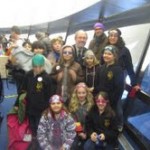Yesterday, some schoolkids in Toronto learned first-hand what democracy is all about.
Toronto’s mayor, Rob Ford, was proposing some cuts to the city’s budget.
He said many of the city’s services should go on the chopping block to balance the city’s budget, including closing down services at: 10 arenas, three daycares, three shelters, a city zoo and a farm on Toronto Island.
The city also proposed cutting services like swimming lessons at five swimming pools in Toronto schools. That could potentially lead to the pools being closed in the future.
The parents and kids at those schools went into action to try to prevent the budget cuts.
At Hillcrest Community School in Toronto, the children wrote letters to their city councillors—many even included drawings—and posted signs saying how important the school’s pool is to them.
On Tuesday, the day the council was voting on the proposed cuts, a troop of parents and kids met at City Hall under a grey, rainy sky. They walked around with signs that said, “Don’t close our pool!”
Then they went into the City Hall’s council chambers to show their support for their local councillor, Joe Mihevc, who presented a petition—including the children’s letters and drawings—against the cuts.

Many of the children were wearing swim towels, goggles and bathing caps. Several were even wearing flippers or a bathing suit on top of their clothes.
Mihevc went into the audience to talk to the parents and kids. He said this type of action—people coming to City Hall—is heartwarming.
Ursula Boylan brought her two daughters to the protest at City Hall. “They are beginning to understand at a young age that your voice can count,” she said. “In some other countries girls are not even allowed to vote or to have a voice. In this respect, in Canada, we are privileged.”
Update: On Tuesday night, Toronto city council voted 23-21 to reverse Mayor Ford’s proposed budget cuts. The pools will not lose their services, and there won’t be cuts to services at the city’s arenas, daycares or homeless shelters.
CURRICULUM CONNECTIONS
By Kathleen Tilly
Writing/Discussion Prompt
What is democracy? How is this an example of democracy?
Can you think of any other examples of democracy in your own life? How are they similar/different to the example in the article?
Reading Prompt:
Identify the point of view of the students and parents who were protesting the cuts. How would their point of view be different from that of Mayor Rob Ford’s?
Could this story be told from someone else’s point of view? Whose? How would it be different?
Primary
Identify the point of view presented in a text and suggest some possible alternative perspectives (OME, Reading: 1.9).
Junior
Identify the point of view presented in texts, ask questions to identify missing of possible alternative points of view, and suggest some possible alternative perspectives (OME, Reading: 1.9).
Intermediate
Identify the point of view presented in texts, including increasingly complex or difficult texts; give evidence of any biases they may contain and suggest other possible perspectives (OME, Reading: 1.9).
Grammar Feature: Writing Lists
When items are written in a list, they are separated by commas. Before the last item is listed the word “and” is written. For example, “10 arenas, three daycares, three shelters, a city zoo and a farm on Toronto Island.”
Identify all of the lists in the article and notice how punctuation is used between each item.







